Improving Higher Education: Reflective Learning and Assessment
VerifiedAdded on 2023/06/17
|9
|1927
|161
Report
AI Summary
This report explores the significance of reflective learning in higher education, emphasizing its role in enhancing assessment through feedback and feedforward mechanisms. It delves into various reflective learning approaches, notably the Gibbs reflective cycle, to demonstrate how students can critically evaluate their learning experiences. The report highlights the importance of feedback and feedforward in formative and summative assessments, illustrating how these processes aid in identifying errors and promoting continuous improvement. Furthermore, it examines how reflective practices inform and improve future assessments by bridging the gap between current performance and desired outcomes, ultimately fostering a deeper understanding and skill development among students. Desklib offers a range of resources, including past papers and solved assignments, to support students in their academic journey.
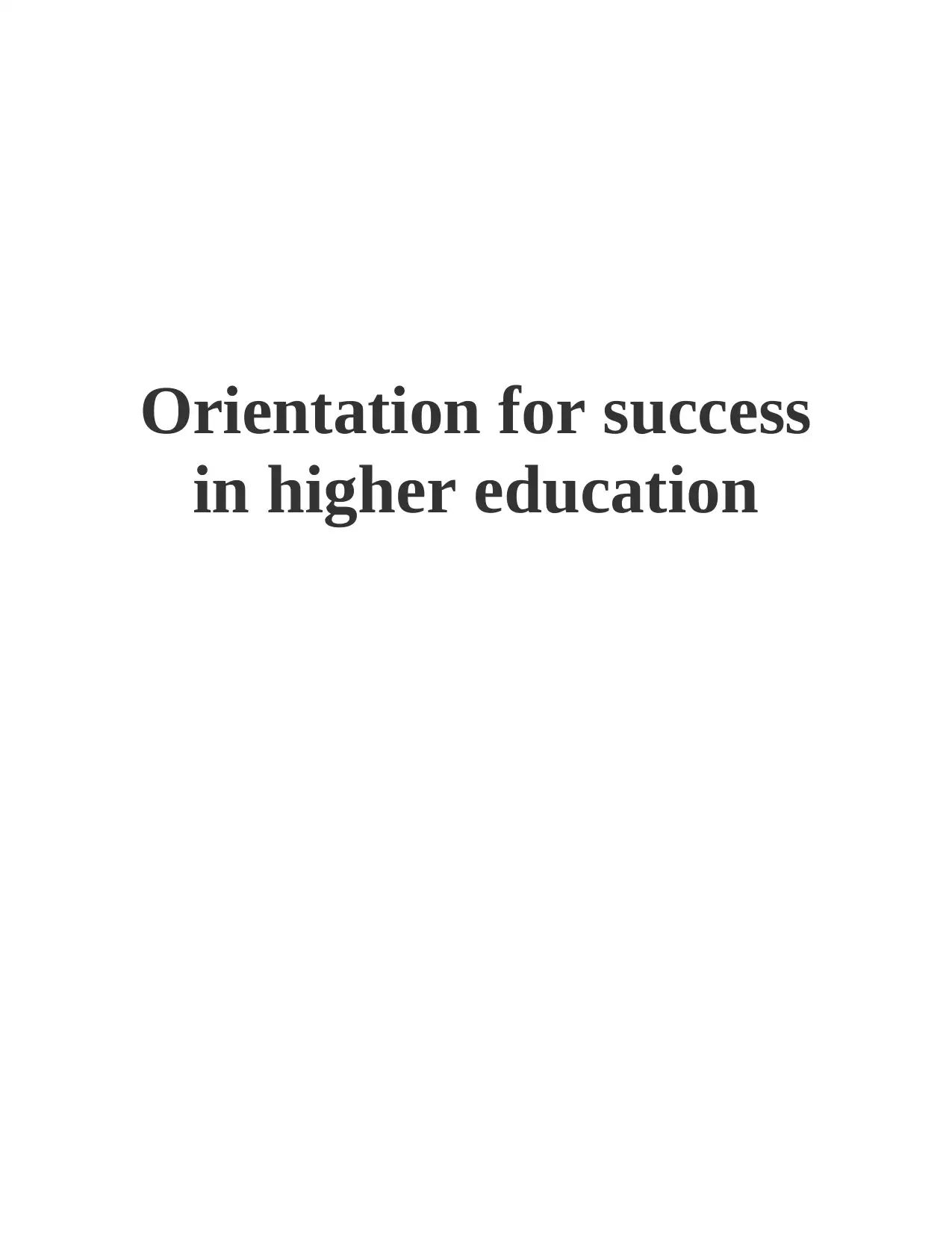
Orientation for success
in higher education
in higher education
Paraphrase This Document
Need a fresh take? Get an instant paraphrase of this document with our AI Paraphraser
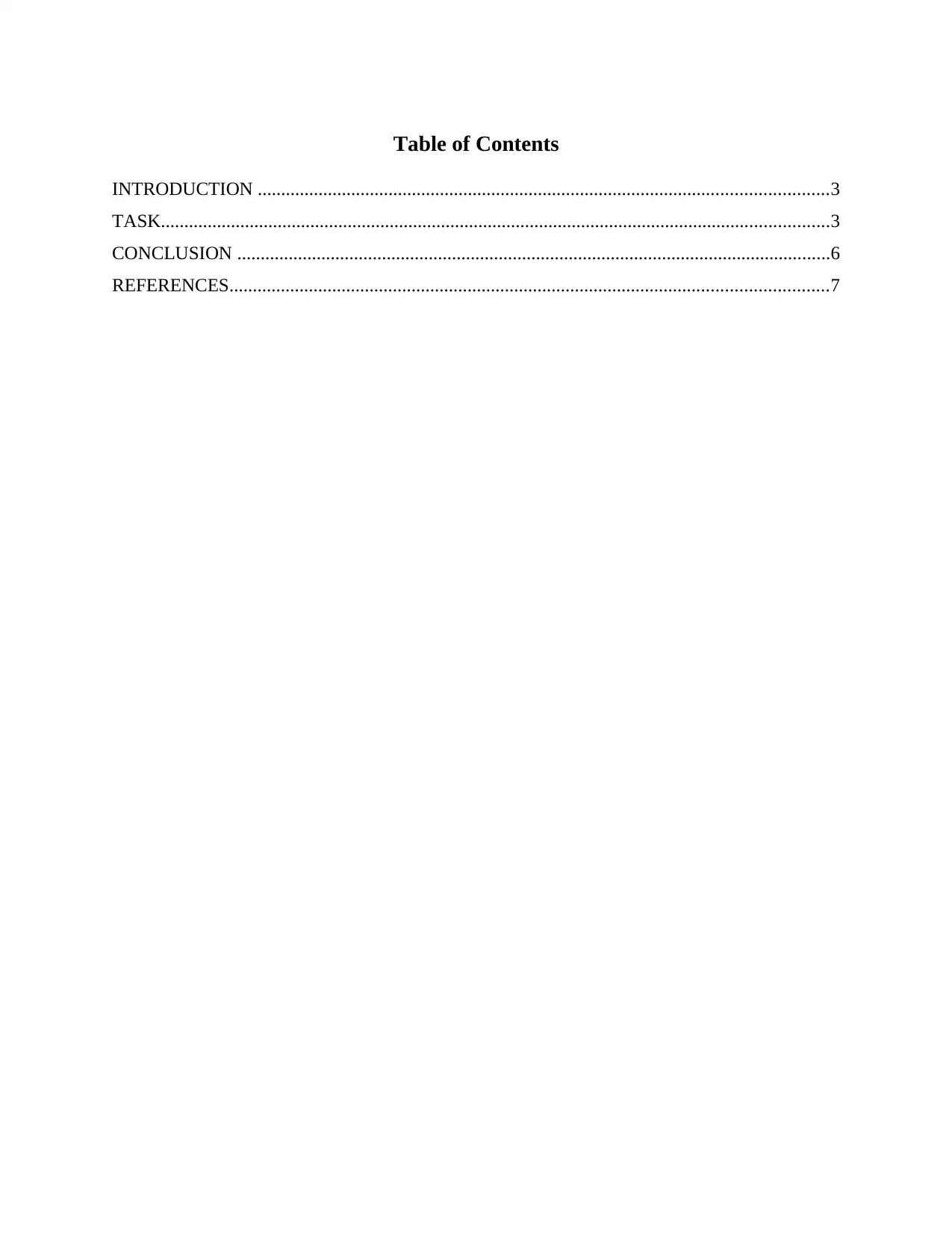
Table of Contents
INTRODUCTION ..........................................................................................................................3
TASK...............................................................................................................................................3
CONCLUSION ...............................................................................................................................6
REFERENCES................................................................................................................................7
INTRODUCTION ..........................................................................................................................3
TASK...............................................................................................................................................3
CONCLUSION ...............................................................................................................................6
REFERENCES................................................................................................................................7
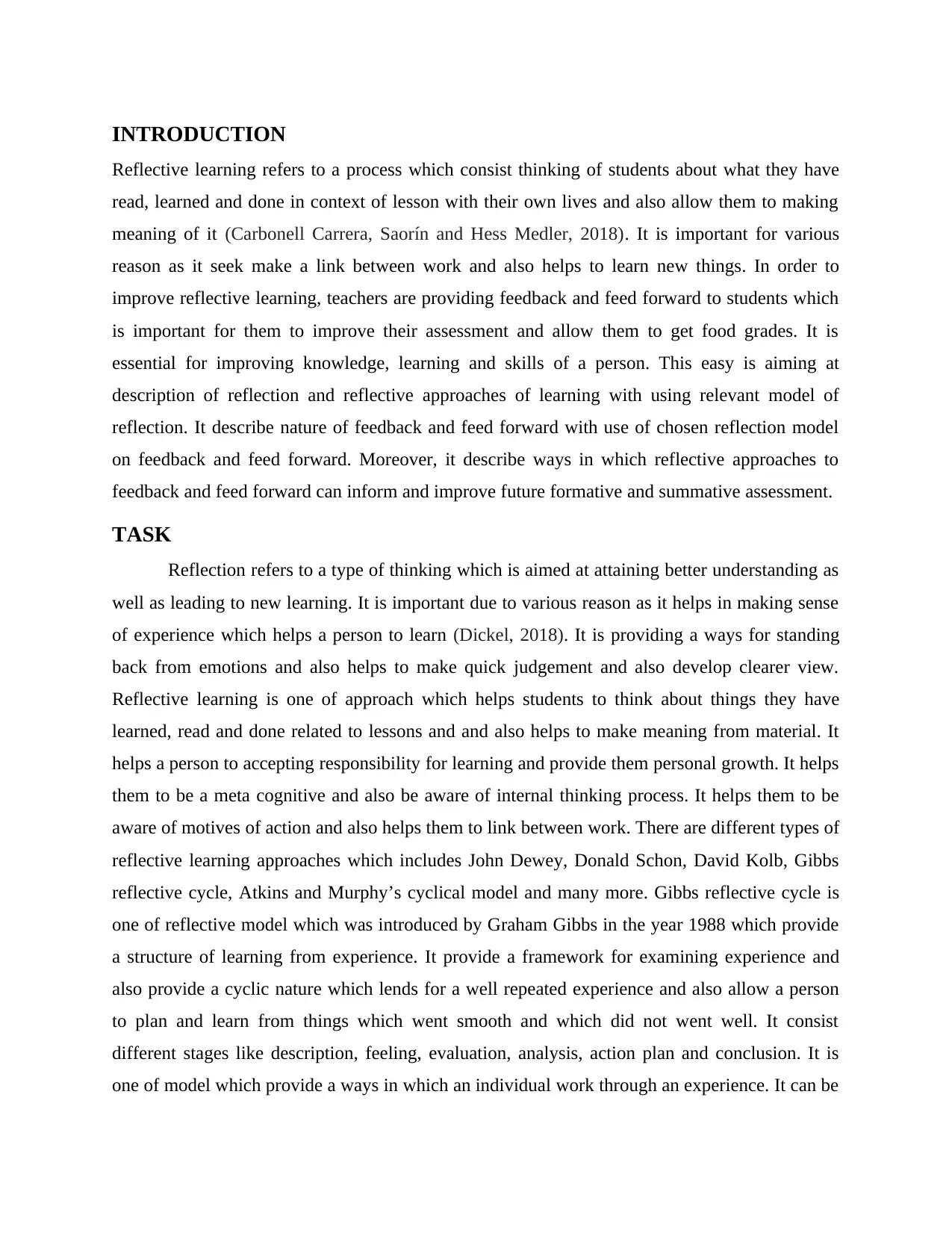
INTRODUCTION
Reflective learning refers to a process which consist thinking of students about what they have
read, learned and done in context of lesson with their own lives and also allow them to making
meaning of it (Carbonell Carrera, Saorín and Hess Medler, 2018). It is important for various
reason as it seek make a link between work and also helps to learn new things. In order to
improve reflective learning, teachers are providing feedback and feed forward to students which
is important for them to improve their assessment and allow them to get food grades. It is
essential for improving knowledge, learning and skills of a person. This easy is aiming at
description of reflection and reflective approaches of learning with using relevant model of
reflection. It describe nature of feedback and feed forward with use of chosen reflection model
on feedback and feed forward. Moreover, it describe ways in which reflective approaches to
feedback and feed forward can inform and improve future formative and summative assessment.
TASK
Reflection refers to a type of thinking which is aimed at attaining better understanding as
well as leading to new learning. It is important due to various reason as it helps in making sense
of experience which helps a person to learn (Dickel, 2018). It is providing a ways for standing
back from emotions and also helps to make quick judgement and also develop clearer view.
Reflective learning is one of approach which helps students to think about things they have
learned, read and done related to lessons and and also helps to make meaning from material. It
helps a person to accepting responsibility for learning and provide them personal growth. It helps
them to be a meta cognitive and also be aware of internal thinking process. It helps them to be
aware of motives of action and also helps them to link between work. There are different types of
reflective learning approaches which includes John Dewey, Donald Schon, David Kolb, Gibbs
reflective cycle, Atkins and Murphy’s cyclical model and many more. Gibbs reflective cycle is
one of reflective model which was introduced by Graham Gibbs in the year 1988 which provide
a structure of learning from experience. It provide a framework for examining experience and
also provide a cyclic nature which lends for a well repeated experience and also allow a person
to plan and learn from things which went smooth and which did not went well. It consist
different stages like description, feeling, evaluation, analysis, action plan and conclusion. It is
one of model which provide a ways in which an individual work through an experience. It can be
Reflective learning refers to a process which consist thinking of students about what they have
read, learned and done in context of lesson with their own lives and also allow them to making
meaning of it (Carbonell Carrera, Saorín and Hess Medler, 2018). It is important for various
reason as it seek make a link between work and also helps to learn new things. In order to
improve reflective learning, teachers are providing feedback and feed forward to students which
is important for them to improve their assessment and allow them to get food grades. It is
essential for improving knowledge, learning and skills of a person. This easy is aiming at
description of reflection and reflective approaches of learning with using relevant model of
reflection. It describe nature of feedback and feed forward with use of chosen reflection model
on feedback and feed forward. Moreover, it describe ways in which reflective approaches to
feedback and feed forward can inform and improve future formative and summative assessment.
TASK
Reflection refers to a type of thinking which is aimed at attaining better understanding as
well as leading to new learning. It is important due to various reason as it helps in making sense
of experience which helps a person to learn (Dickel, 2018). It is providing a ways for standing
back from emotions and also helps to make quick judgement and also develop clearer view.
Reflective learning is one of approach which helps students to think about things they have
learned, read and done related to lessons and and also helps to make meaning from material. It
helps a person to accepting responsibility for learning and provide them personal growth. It helps
them to be a meta cognitive and also be aware of internal thinking process. It helps them to be
aware of motives of action and also helps them to link between work. There are different types of
reflective learning approaches which includes John Dewey, Donald Schon, David Kolb, Gibbs
reflective cycle, Atkins and Murphy’s cyclical model and many more. Gibbs reflective cycle is
one of reflective model which was introduced by Graham Gibbs in the year 1988 which provide
a structure of learning from experience. It provide a framework for examining experience and
also provide a cyclic nature which lends for a well repeated experience and also allow a person
to plan and learn from things which went smooth and which did not went well. It consist
different stages like description, feeling, evaluation, analysis, action plan and conclusion. It is
one of model which provide a ways in which an individual work through an experience. It can be
⊘ This is a preview!⊘
Do you want full access?
Subscribe today to unlock all pages.

Trusted by 1+ million students worldwide
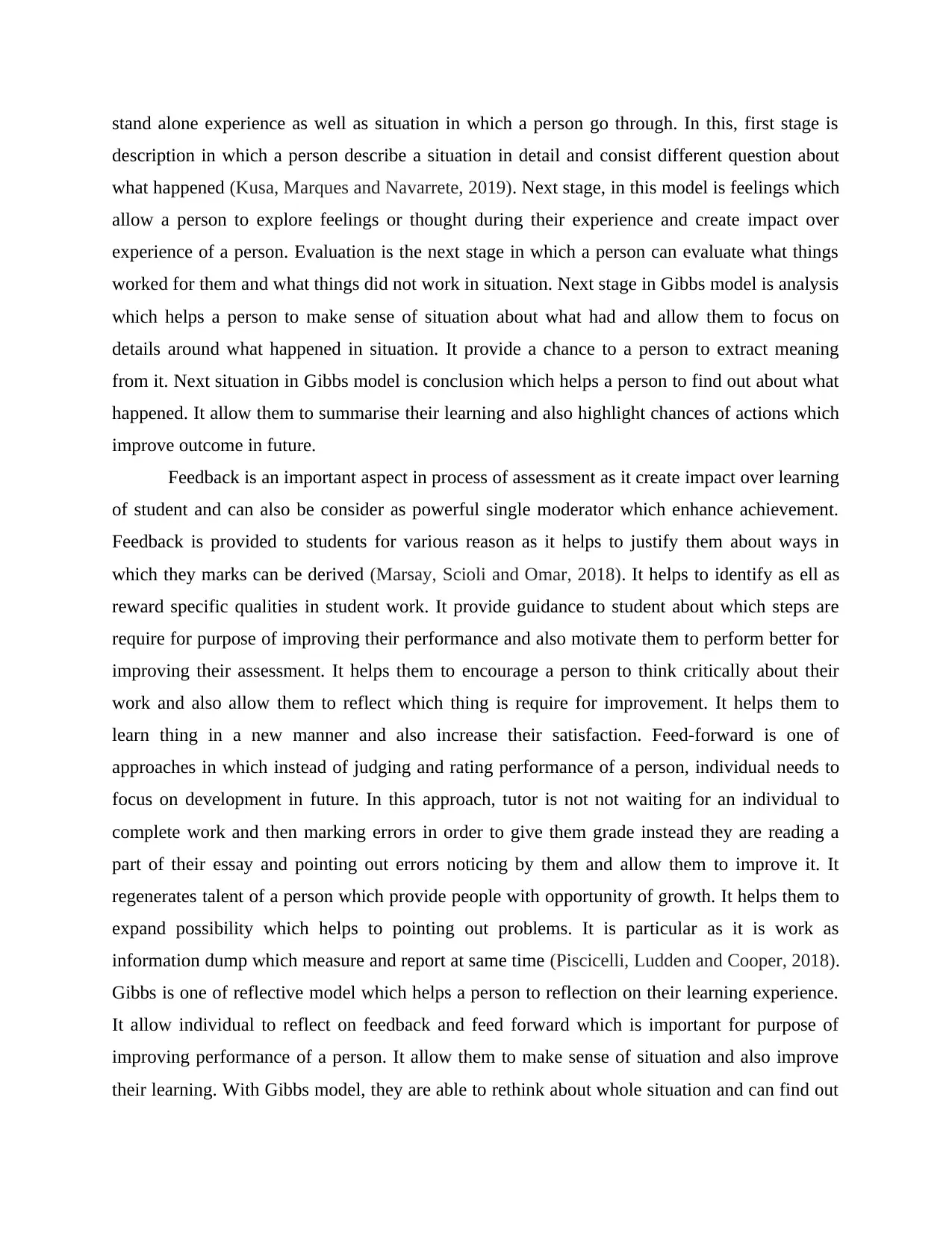
stand alone experience as well as situation in which a person go through. In this, first stage is
description in which a person describe a situation in detail and consist different question about
what happened (Kusa, Marques and Navarrete, 2019). Next stage, in this model is feelings which
allow a person to explore feelings or thought during their experience and create impact over
experience of a person. Evaluation is the next stage in which a person can evaluate what things
worked for them and what things did not work in situation. Next stage in Gibbs model is analysis
which helps a person to make sense of situation about what had and allow them to focus on
details around what happened in situation. It provide a chance to a person to extract meaning
from it. Next situation in Gibbs model is conclusion which helps a person to find out about what
happened. It allow them to summarise their learning and also highlight chances of actions which
improve outcome in future.
Feedback is an important aspect in process of assessment as it create impact over learning
of student and can also be consider as powerful single moderator which enhance achievement.
Feedback is provided to students for various reason as it helps to justify them about ways in
which they marks can be derived (Marsay, Scioli and Omar, 2018). It helps to identify as ell as
reward specific qualities in student work. It provide guidance to student about which steps are
require for purpose of improving their performance and also motivate them to perform better for
improving their assessment. It helps them to encourage a person to think critically about their
work and also allow them to reflect which thing is require for improvement. It helps them to
learn thing in a new manner and also increase their satisfaction. Feed-forward is one of
approaches in which instead of judging and rating performance of a person, individual needs to
focus on development in future. In this approach, tutor is not not waiting for an individual to
complete work and then marking errors in order to give them grade instead they are reading a
part of their essay and pointing out errors noticing by them and allow them to improve it. It
regenerates talent of a person which provide people with opportunity of growth. It helps them to
expand possibility which helps to pointing out problems. It is particular as it is work as
information dump which measure and report at same time (Piscicelli, Ludden and Cooper, 2018).
Gibbs is one of reflective model which helps a person to reflection on their learning experience.
It allow individual to reflect on feedback and feed forward which is important for purpose of
improving performance of a person. It allow them to make sense of situation and also improve
their learning. With Gibbs model, they are able to rethink about whole situation and can find out
description in which a person describe a situation in detail and consist different question about
what happened (Kusa, Marques and Navarrete, 2019). Next stage, in this model is feelings which
allow a person to explore feelings or thought during their experience and create impact over
experience of a person. Evaluation is the next stage in which a person can evaluate what things
worked for them and what things did not work in situation. Next stage in Gibbs model is analysis
which helps a person to make sense of situation about what had and allow them to focus on
details around what happened in situation. It provide a chance to a person to extract meaning
from it. Next situation in Gibbs model is conclusion which helps a person to find out about what
happened. It allow them to summarise their learning and also highlight chances of actions which
improve outcome in future.
Feedback is an important aspect in process of assessment as it create impact over learning
of student and can also be consider as powerful single moderator which enhance achievement.
Feedback is provided to students for various reason as it helps to justify them about ways in
which they marks can be derived (Marsay, Scioli and Omar, 2018). It helps to identify as ell as
reward specific qualities in student work. It provide guidance to student about which steps are
require for purpose of improving their performance and also motivate them to perform better for
improving their assessment. It helps them to encourage a person to think critically about their
work and also allow them to reflect which thing is require for improvement. It helps them to
learn thing in a new manner and also increase their satisfaction. Feed-forward is one of
approaches in which instead of judging and rating performance of a person, individual needs to
focus on development in future. In this approach, tutor is not not waiting for an individual to
complete work and then marking errors in order to give them grade instead they are reading a
part of their essay and pointing out errors noticing by them and allow them to improve it. It
regenerates talent of a person which provide people with opportunity of growth. It helps them to
expand possibility which helps to pointing out problems. It is particular as it is work as
information dump which measure and report at same time (Piscicelli, Ludden and Cooper, 2018).
Gibbs is one of reflective model which helps a person to reflection on their learning experience.
It allow individual to reflect on feedback and feed forward which is important for purpose of
improving performance of a person. It allow them to make sense of situation and also improve
their learning. With Gibbs model, they are able to rethink about whole situation and can find out
Paraphrase This Document
Need a fresh take? Get an instant paraphrase of this document with our AI Paraphraser
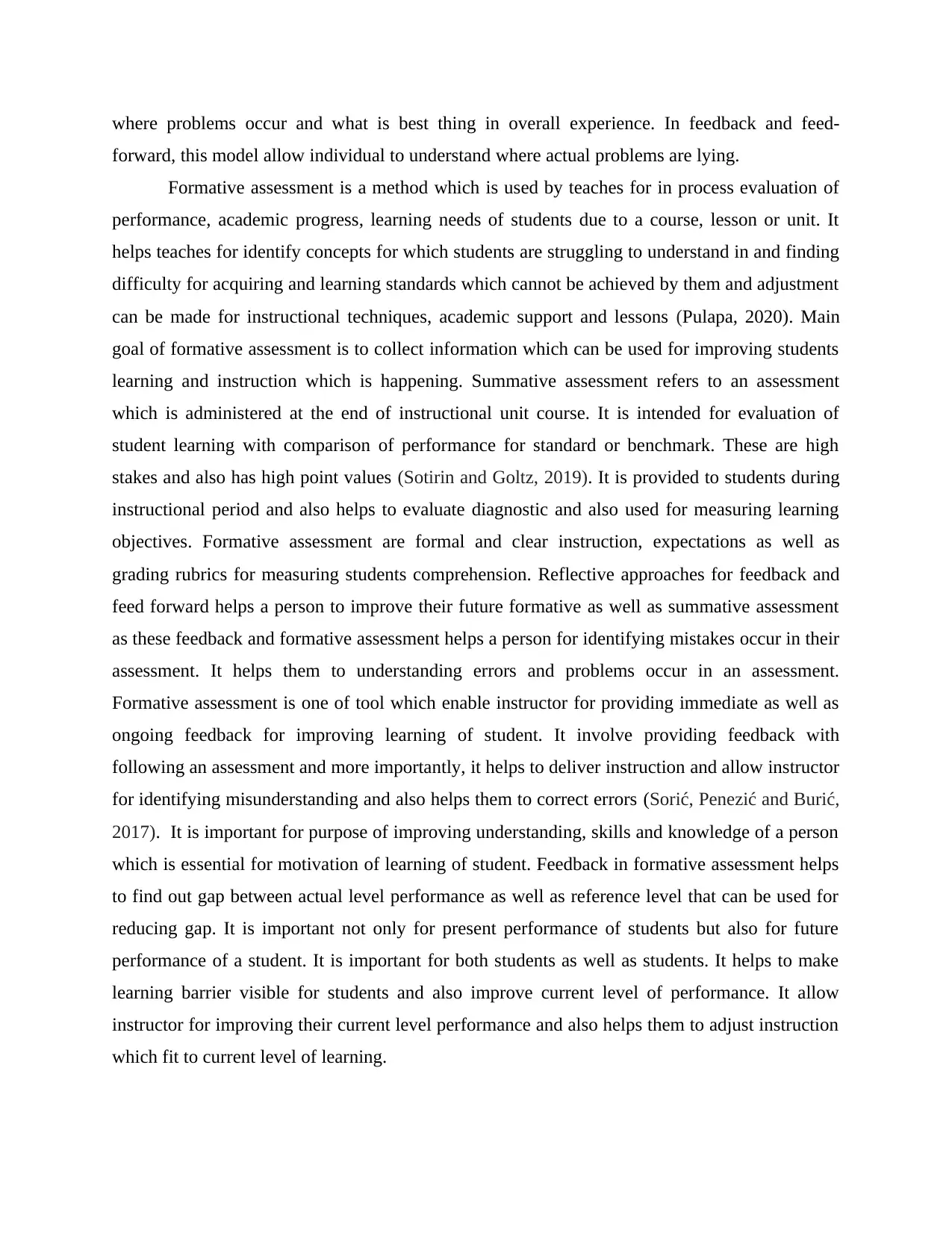
where problems occur and what is best thing in overall experience. In feedback and feed-
forward, this model allow individual to understand where actual problems are lying.
Formative assessment is a method which is used by teaches for in process evaluation of
performance, academic progress, learning needs of students due to a course, lesson or unit. It
helps teaches for identify concepts for which students are struggling to understand in and finding
difficulty for acquiring and learning standards which cannot be achieved by them and adjustment
can be made for instructional techniques, academic support and lessons (Pulapa, 2020). Main
goal of formative assessment is to collect information which can be used for improving students
learning and instruction which is happening. Summative assessment refers to an assessment
which is administered at the end of instructional unit course. It is intended for evaluation of
student learning with comparison of performance for standard or benchmark. These are high
stakes and also has high point values (Sotirin and Goltz, 2019). It is provided to students during
instructional period and also helps to evaluate diagnostic and also used for measuring learning
objectives. Formative assessment are formal and clear instruction, expectations as well as
grading rubrics for measuring students comprehension. Reflective approaches for feedback and
feed forward helps a person to improve their future formative as well as summative assessment
as these feedback and formative assessment helps a person for identifying mistakes occur in their
assessment. It helps them to understanding errors and problems occur in an assessment.
Formative assessment is one of tool which enable instructor for providing immediate as well as
ongoing feedback for improving learning of student. It involve providing feedback with
following an assessment and more importantly, it helps to deliver instruction and allow instructor
for identifying misunderstanding and also helps them to correct errors (Sorić, Penezić and Burić,
2017). It is important for purpose of improving understanding, skills and knowledge of a person
which is essential for motivation of learning of student. Feedback in formative assessment helps
to find out gap between actual level performance as well as reference level that can be used for
reducing gap. It is important not only for present performance of students but also for future
performance of a student. It is important for both students as well as students. It helps to make
learning barrier visible for students and also improve current level of performance. It allow
instructor for improving their current level performance and also helps them to adjust instruction
which fit to current level of learning.
forward, this model allow individual to understand where actual problems are lying.
Formative assessment is a method which is used by teaches for in process evaluation of
performance, academic progress, learning needs of students due to a course, lesson or unit. It
helps teaches for identify concepts for which students are struggling to understand in and finding
difficulty for acquiring and learning standards which cannot be achieved by them and adjustment
can be made for instructional techniques, academic support and lessons (Pulapa, 2020). Main
goal of formative assessment is to collect information which can be used for improving students
learning and instruction which is happening. Summative assessment refers to an assessment
which is administered at the end of instructional unit course. It is intended for evaluation of
student learning with comparison of performance for standard or benchmark. These are high
stakes and also has high point values (Sotirin and Goltz, 2019). It is provided to students during
instructional period and also helps to evaluate diagnostic and also used for measuring learning
objectives. Formative assessment are formal and clear instruction, expectations as well as
grading rubrics for measuring students comprehension. Reflective approaches for feedback and
feed forward helps a person to improve their future formative as well as summative assessment
as these feedback and formative assessment helps a person for identifying mistakes occur in their
assessment. It helps them to understanding errors and problems occur in an assessment.
Formative assessment is one of tool which enable instructor for providing immediate as well as
ongoing feedback for improving learning of student. It involve providing feedback with
following an assessment and more importantly, it helps to deliver instruction and allow instructor
for identifying misunderstanding and also helps them to correct errors (Sorić, Penezić and Burić,
2017). It is important for purpose of improving understanding, skills and knowledge of a person
which is essential for motivation of learning of student. Feedback in formative assessment helps
to find out gap between actual level performance as well as reference level that can be used for
reducing gap. It is important not only for present performance of students but also for future
performance of a student. It is important for both students as well as students. It helps to make
learning barrier visible for students and also improve current level of performance. It allow
instructor for improving their current level performance and also helps them to adjust instruction
which fit to current level of learning.
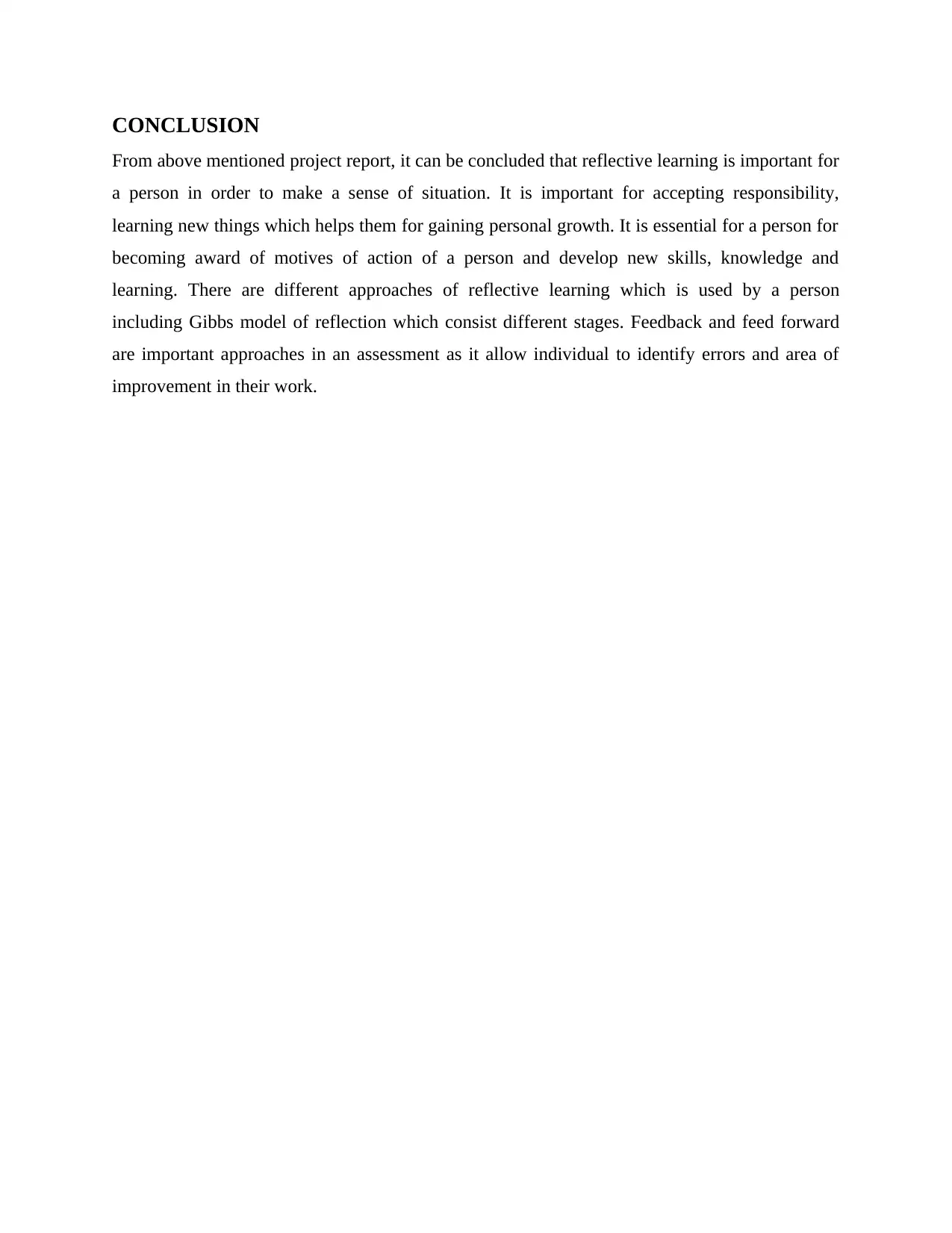
CONCLUSION
From above mentioned project report, it can be concluded that reflective learning is important for
a person in order to make a sense of situation. It is important for accepting responsibility,
learning new things which helps them for gaining personal growth. It is essential for a person for
becoming award of motives of action of a person and develop new skills, knowledge and
learning. There are different approaches of reflective learning which is used by a person
including Gibbs model of reflection which consist different stages. Feedback and feed forward
are important approaches in an assessment as it allow individual to identify errors and area of
improvement in their work.
From above mentioned project report, it can be concluded that reflective learning is important for
a person in order to make a sense of situation. It is important for accepting responsibility,
learning new things which helps them for gaining personal growth. It is essential for a person for
becoming award of motives of action of a person and develop new skills, knowledge and
learning. There are different approaches of reflective learning which is used by a person
including Gibbs model of reflection which consist different stages. Feedback and feed forward
are important approaches in an assessment as it allow individual to identify errors and area of
improvement in their work.
⊘ This is a preview!⊘
Do you want full access?
Subscribe today to unlock all pages.

Trusted by 1+ million students worldwide
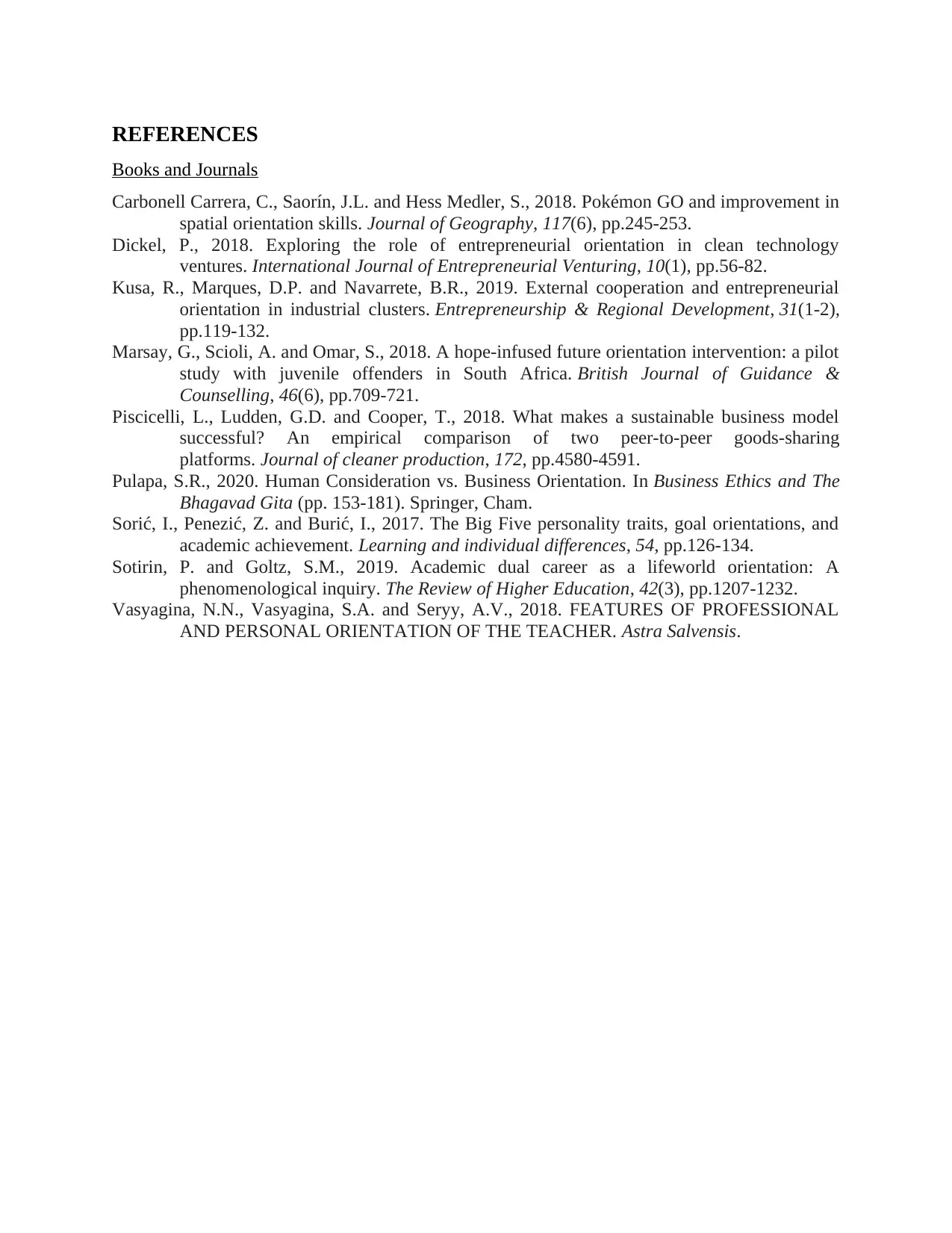
REFERENCES
Books and Journals
Carbonell Carrera, C., Saorín, J.L. and Hess Medler, S., 2018. Pokémon GO and improvement in
spatial orientation skills. Journal of Geography, 117(6), pp.245-253.
Dickel, P., 2018. Exploring the role of entrepreneurial orientation in clean technology
ventures. International Journal of Entrepreneurial Venturing, 10(1), pp.56-82.
Kusa, R., Marques, D.P. and Navarrete, B.R., 2019. External cooperation and entrepreneurial
orientation in industrial clusters. Entrepreneurship & Regional Development, 31(1-2),
pp.119-132.
Marsay, G., Scioli, A. and Omar, S., 2018. A hope-infused future orientation intervention: a pilot
study with juvenile offenders in South Africa. British Journal of Guidance &
Counselling, 46(6), pp.709-721.
Piscicelli, L., Ludden, G.D. and Cooper, T., 2018. What makes a sustainable business model
successful? An empirical comparison of two peer-to-peer goods-sharing
platforms. Journal of cleaner production, 172, pp.4580-4591.
Pulapa, S.R., 2020. Human Consideration vs. Business Orientation. In Business Ethics and The
Bhagavad Gita (pp. 153-181). Springer, Cham.
Sorić, I., Penezić, Z. and Burić, I., 2017. The Big Five personality traits, goal orientations, and
academic achievement. Learning and individual differences, 54, pp.126-134.
Sotirin, P. and Goltz, S.M., 2019. Academic dual career as a lifeworld orientation: A
phenomenological inquiry. The Review of Higher Education, 42(3), pp.1207-1232.
Vasyagina, N.N., Vasyagina, S.A. and Seryy, A.V., 2018. FEATURES OF PROFESSIONAL
AND PERSONAL ORIENTATION OF THE TEACHER. Astra Salvensis.
Books and Journals
Carbonell Carrera, C., Saorín, J.L. and Hess Medler, S., 2018. Pokémon GO and improvement in
spatial orientation skills. Journal of Geography, 117(6), pp.245-253.
Dickel, P., 2018. Exploring the role of entrepreneurial orientation in clean technology
ventures. International Journal of Entrepreneurial Venturing, 10(1), pp.56-82.
Kusa, R., Marques, D.P. and Navarrete, B.R., 2019. External cooperation and entrepreneurial
orientation in industrial clusters. Entrepreneurship & Regional Development, 31(1-2),
pp.119-132.
Marsay, G., Scioli, A. and Omar, S., 2018. A hope-infused future orientation intervention: a pilot
study with juvenile offenders in South Africa. British Journal of Guidance &
Counselling, 46(6), pp.709-721.
Piscicelli, L., Ludden, G.D. and Cooper, T., 2018. What makes a sustainable business model
successful? An empirical comparison of two peer-to-peer goods-sharing
platforms. Journal of cleaner production, 172, pp.4580-4591.
Pulapa, S.R., 2020. Human Consideration vs. Business Orientation. In Business Ethics and The
Bhagavad Gita (pp. 153-181). Springer, Cham.
Sorić, I., Penezić, Z. and Burić, I., 2017. The Big Five personality traits, goal orientations, and
academic achievement. Learning and individual differences, 54, pp.126-134.
Sotirin, P. and Goltz, S.M., 2019. Academic dual career as a lifeworld orientation: A
phenomenological inquiry. The Review of Higher Education, 42(3), pp.1207-1232.
Vasyagina, N.N., Vasyagina, S.A. and Seryy, A.V., 2018. FEATURES OF PROFESSIONAL
AND PERSONAL ORIENTATION OF THE TEACHER. Astra Salvensis.
Paraphrase This Document
Need a fresh take? Get an instant paraphrase of this document with our AI Paraphraser


⊘ This is a preview!⊘
Do you want full access?
Subscribe today to unlock all pages.

Trusted by 1+ million students worldwide
1 out of 9
Related Documents
Your All-in-One AI-Powered Toolkit for Academic Success.
+13062052269
info@desklib.com
Available 24*7 on WhatsApp / Email
![[object Object]](/_next/static/media/star-bottom.7253800d.svg)
Unlock your academic potential
Copyright © 2020–2025 A2Z Services. All Rights Reserved. Developed and managed by ZUCOL.

